A sewing machine laser guide projects a beam of light to help align fabric and stitches accurately. It enhances precision, simplifies straight stitching, and improves quilting projects, making sewing tasks easier and more efficient for both beginners and professionals.
1.1 Overview of the Laser Guide Technology
The laser guide technology in sewing machines uses a focused beam of light to provide a precise visual reference for aligning fabric and stitches. This innovative tool projects a straight or crosshair pattern onto the fabric, ensuring accurate stitching and seam placement. Unlike traditional sewing guides, the laser beam is highly visible and adjustable, making it ideal for various fabrics and projects; It eliminates the need for manual marking and reduces errors, especially in quilting, embroidery, and straight-line sewing. The technology is integrated into the machine or available as an attachable accessory, offering versatility and convenience for sewists of all skill levels.
1.2 Importance of Precision in Sewing
Precision is crucial in sewing to ensure professional results and avoid costly mistakes. Even slight misalignments can ruin a project, especially in intricate patterns or large-scale designs. The laser guide enhances accuracy by providing a clear, consistent reference point, eliminating guesswork. This is particularly vital for tasks like quilting, embroidery, and straight-line stitching, where alignment errors can be noticeable. By maintaining precise control over fabric placement and stitch alignment, sewists can achieve flawless finishes and professional-quality results, making precision a cornerstone of successful sewing projects.
1.3 Brief History of Sewing Machine Innovations
The evolution of sewing machines has been marked by continuous innovation. The first mechanical sewing machine, invented by Elias Howe in 1846, revolutionized textiles. Over time, advancements like automatic stitch regulation and computerized controls improved functionality. The introduction of laser guides represents the latest leap, offering unparalleled precision. This technology builds on decades of refinement, from mechanical to digital systems, ensuring that modern sewists can achieve professional-quality results with ease. The laser guide embodies the culmination of these advancements, making it an indispensable tool for today’s sewing enthusiasts and professionals alike.
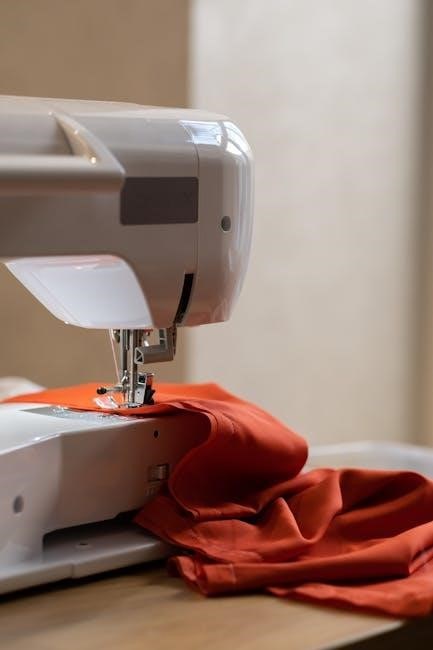
Benefits of Using a Laser Guide
A laser guide enhances sewing accuracy, saves time, and improves fabric alignment. It offers versatility for various projects, ensuring professional results and boosting efficiency for both beginners and experts.
2.1 Enhanced Sewing Accuracy
The laser guide significantly improves sewing accuracy by providing a clear, visible path for the needle; This ensures straight, consistent stitches and reduces deviations, especially on large or intricate projects. By projecting a precise beam, it helps maintain alignment, making it ideal for quilting and straight-line stitching. The visual cue minimizes human error, allowing for professional-level results. This feature is particularly beneficial for beginners, as it builds confidence and skill. Overall, the laser guide transforms sewing into a more precise and enjoyable experience, ensuring every stitch meets high standards of quality and consistency.
2.2 Time-Saving with Guided Stitching
The laser guide streamlines the sewing process, saving valuable time by eliminating the need for constant adjustments and measurements. By providing a clear visual path, it allows for faster fabric alignment and stitch placement, reducing the likelihood of errors. This feature is especially beneficial for complex or large-scale projects, where maintaining consistent stitching is time-consuming. The guided stitching ensures that fabric moves smoothly under the needle, enabling sewists to work more efficiently. Whether quilting, embroidery, or straight-line sewing, the laser guide accelerates the creative process, allowing for more projects to be completed in less time without compromising quality.
2.3 Improved Fabric Alignment
The laser guide significantly enhances fabric alignment by projecting a clear, visible path for the fabric to follow. This reduces the need for manual adjustments and ensures that the fabric stays precisely positioned as it moves under the needle. The laser beam acts as a consistent reference point, making it easier to maintain straight lines and proper spacing, especially for intricate patterns or large-scale projects. Improved alignment leads to fewer mistakes and a more professional finish, making the sewing process smoother and more enjoyable for sewists of all skill levels.
2.4 Versatility in Various Sewing Projects
A sewing machine laser guide offers unparalleled versatility across diverse sewing projects. Whether quilting, embroidery, or crafting intricate designs, the laser beam provides a precise guide for aligning patterns and fabric layers. It excels in both straight-line stitching and curved seams, allowing for consistent results. The guide is particularly beneficial for large-scale projects, such as quilts, where maintaining accuracy across extensive fabric surfaces is crucial. Its adaptability ensures that it can be used effectively in various creative endeavors, making it an indispensable tool for sewists tackling complex or multi-faceted tasks. This versatility enhances productivity and creativity, ensuring professional-quality outcomes every time.
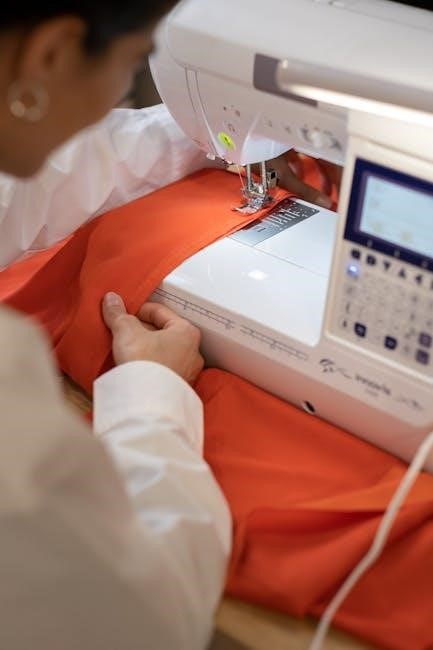
Types of Laser Guides
Laser guides for sewing machines come in three main types: built-in, attachable, and portable. Each offers unique benefits, catering to different sewing needs and preferences, ensuring precision and ease.
3.1 Built-In Laser Guides
Built-in laser guides are integrated directly into high-end sewing machines, offering seamless precision. They project a consistent beam, aligning fabrics effortlessly and ensuring straight stitching. Ideal for quilting and embroidery, these lasers are pre-calibrated, eliminating the need for adjustments. They often come with adjustable brightness and focus settings, accommodating various fabrics and lighting conditions. Users praise their reliability and durability, as they are designed to withstand heavy use. This feature is particularly favored by professionals and serious hobbyists seeking unmatched accuracy and efficiency in their projects, making it a worthwhile investment for those who value superior stitching quality and convenience.
3.2 Attachable Laser Accessories
Attachable laser accessories offer flexibility for sewists who prefer not to invest in a new machine. These devices can be mounted on various sewing machine models, providing a laser guide without modifying the equipment. They are ideal for those who want to enhance their current setup. Many accessories are adjustable, allowing users to customize the beam’s position and angle. Portable and easy to install, they cater to different sewing projects, from straight stitching to intricate designs. Their affordability and versatility make them a popular choice for hobbyists and professionals alike, ensuring precision without committing to a built-in laser system.
3.3 Portable Laser Alignment Tools
Portable laser alignment tools are standalone devices designed to enhance sewing accuracy without being permanently attached to a machine. These compact tools can be placed anywhere near the sewing area, offering flexibility for various projects. They are particularly useful for large-scale or intricate designs, where precise fabric alignment is crucial. Many portable lasers are battery-powered, making them easy to move and use. Their adjustable beams allow for customization, ensuring accuracy on different fabrics and stitching patterns. Ideal for both hobbyists and professionals, these tools provide versatility and convenience, making them a valuable addition to any sewing setup.
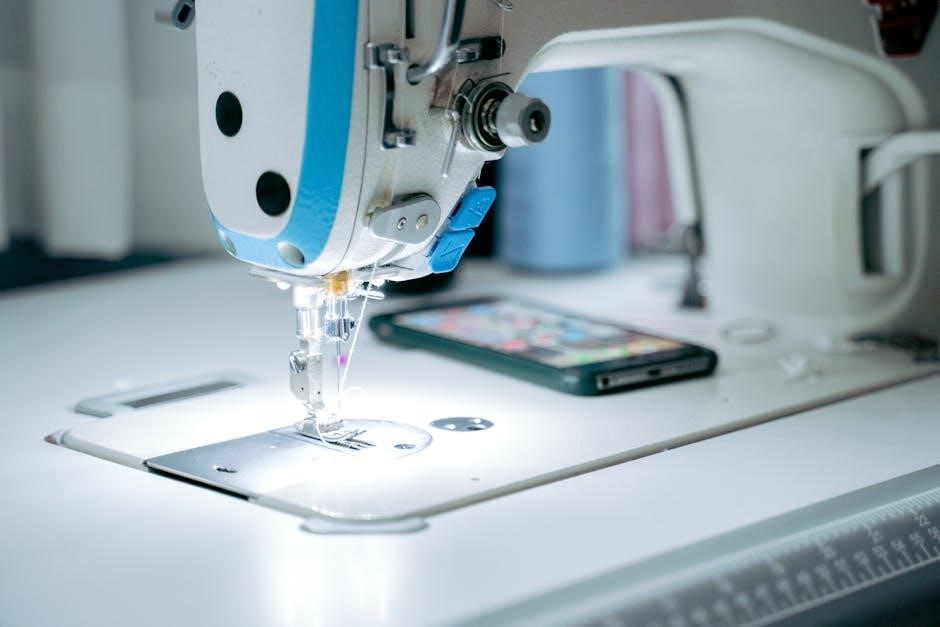
How the Laser Guide Works
The laser guide projects a beam of light to align fabric and stitches accurately. It helps sewists maintain straight lines and precise patterns, enhancing overall sewing efficiency.
4.1 Technology Behind the Laser Beam
The laser beam in sewing machines is generated by a compact laser diode, emitting a focused, low-intensity red or green light. This technology ensures a precise alignment of fabric and stitching. The beam is controlled by optical components that maintain its stability and direction. Sensors adjust the beam’s position based on fabric thickness and stitch settings, optimizing accuracy. The laser guide operates at a safe wavelength, posing no risk to users. This advanced optical system is integrated into the machine, providing real-time guidance for straight lines, patterns, and intricate designs, making it invaluable for both amateur and professional sewists. It enhances sewing efficiency and consistency across various projects.
4.2 Adjusting the Laser for Different Fabrics
Adjusting the laser guide for various fabrics ensures optimal alignment and accuracy. For delicate fabrics, reduce the laser’s brightness to avoid scorching or marking. Thicker materials like denim may require increasing the beam’s intensity for visibility. The laser’s angle and position can be fine-tuned to accommodate fabric thickness and texture. Some machines offer preset fabric settings, while others allow manual calibration. Proper adjustment enhances the laser’s effectiveness, ensuring precise stitching regardless of the fabric type. This feature is particularly useful for quilters and sewists working with diverse materials, making the laser guide a versatile tool for all sewing projects.
4.3 Synchronizing the Laser with Stitch Settings
Synchronizing the laser guide with stitch settings ensures seamless integration with your sewing machine’s functions. The laser beam aligns with the selected stitch type, whether it’s a straight stitch, zigzag, or decorative pattern. Adjustments can be made to match the stitch length and width, ensuring the laser accurately reflects the machine’s stitching path. This synchronization is crucial for maintaining consistency, especially in complex projects like embroidery or quilting. Advanced machines may offer automatic synchronization, while others require manual calibration. Proper alignment enhances stitching accuracy and overall project quality, making the laser guide an essential tool for precise sewing.

Accuracy and Consistency
A sewing machine laser guide ensures precise stitching and consistent results, minimizing errors and enabling professional-level accuracy in every project, from simple seams to intricate designs.
5.1 Reducing Errors in Straight Stitching
A sewing machine laser guide significantly reduces errors in straight stitching by providing a clear, visible alignment reference. This tool ensures that fabric stays properly positioned, minimizing uneven seams and misalignments. The laser beam acts as a constant guide, allowing sewists to maintain precision without manual marking or constant adjustments. This is especially beneficial for long or intricate straight-stitch projects, such as quilting or home decor sewing. By eliminating guesswork, the laser guide boosts accuracy and consistency, enabling sewists to achieve professional-quality results with confidence.
5.2 Achieving Professional-Level Results
The laser guide on a sewing machine is instrumental in achieving professional-level results by ensuring precise fabric alignment and consistent stitching. This tool is particularly beneficial for intricate designs, as it provides a clear visual reference, eliminating the need for manual adjustments. The laser beam helps maintain uniform spacing and straight lines, which is essential for high-quality finishes. Whether it’s quilting, embroidery, or home decor projects, the laser guide elevates craftsmanship, enabling sewists to produce work that rivals professional outputs. Its ability to enhance accuracy and reduce human error makes it an indispensable asset for achieving polished, professional-looking results with every stitch.
5.3 Consistency in Large-Scale Projects
In large-scale sewing projects, maintaining consistency is crucial for achieving uniform results. The laser guide ensures that every stitch aligns perfectly, even when working with extensive fabric lengths. This tool is particularly valuable for quilting, drapes, or industrial sewing, where precision over large areas is essential. By providing a constant visual reference, the laser guide minimizes deviations and ensures that patterns and seams remain consistent throughout. This level of reliability is especially important in commercial settings, where producing identical pieces efficiently is a priority. The laser guide’s ability to maintain accuracy across vast projects makes it an indispensable asset for achieving professional-grade consistency.
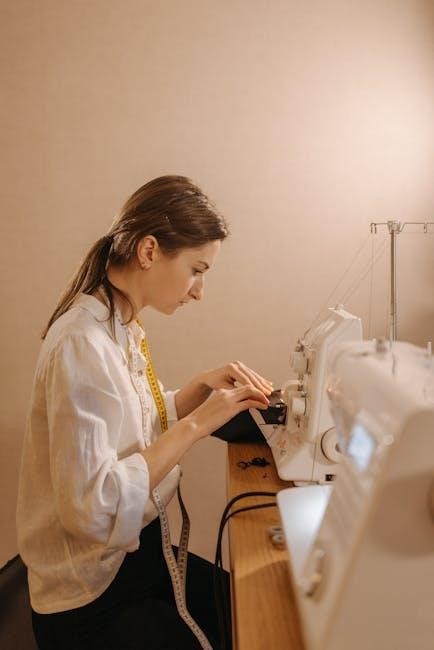
Maintenance and Care Tips
Regularly clean the laser guide with a soft cloth to ensure clarity. Check alignment periodically and use the correct power source. Avoid direct sunlight exposure to maintain accuracy and store properly when not in use.
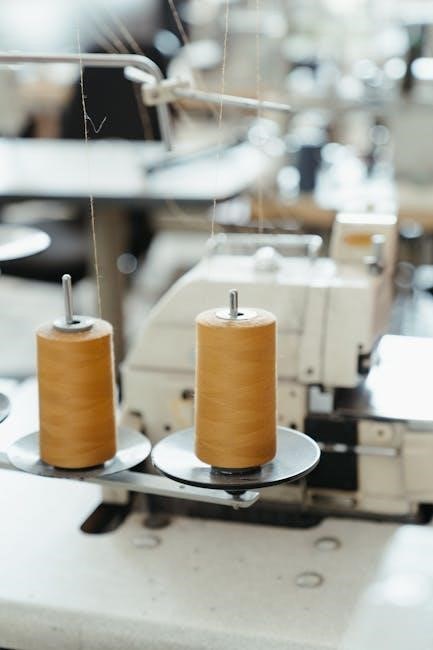
6.1 Cleaning the Laser Guide
Cleaning the laser guide is essential for maintaining its accuracy and performance. Turn off the sewing machine and unplug it for safety. Use a soft, dry microfiber cloth to gently wipe away any dust, debris, or fabric lint from the laser lens. Avoid using harsh chemicals, abrasive materials, or moistened cloths, as they may damage the lens or leave streaks. For stubborn smudges, lightly dampen the cloth with distilled water, but ensure it is thoroughly dry before wiping the lens. Regular cleaning prevents obstructed laser beams and ensures precise alignment for your sewing projects.
6.2 Adjusting the Laser Alignment
Adjusting the laser alignment ensures accurate stitching and proper fabric guidance. Locate the small adjustment screws near the laser guide, typically found on the machine’s side or top. Use a screwdriver to gently turn the screws, aligning the laser beam with the needle or desired stitching path. Test the alignment by moving the fabric under the beam to ensure it stays consistent. If the laser drifts, repeat the process until it stabilizes. Some machines may have digital controls for easier calibration. Proper alignment is crucial for maintaining the laser’s effectiveness and ensuring precise results in your sewing projects.
6.3 Troubleshooting Common Issues
Troubleshooting common issues with your sewing machine laser guide can help maintain its functionality. If the laser beam appears dim, check the power source or replace the battery. Misalignment issues can often be resolved by recalibrating the guide. If the beam flickers, ensure the machine is on a stable surface. For blocked beams, clean the lens with a soft cloth. If problems persist, consult the user manual or contact customer support. Regular maintenance and quick troubleshooting steps can prevent downtime and keep your laser guide performing optimally for precise stitching and fabric alignment.
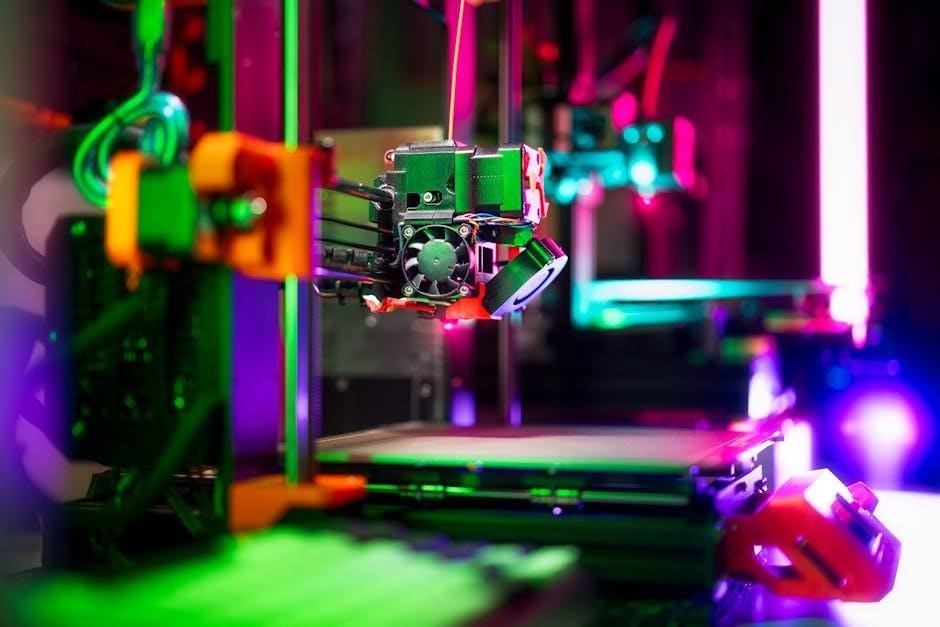
Choosing the Right Sewing Machine
Selecting a sewing machine with a laser guide involves considering built-in or attachable options, fabric compatibility, and stitch precision. Compare brands and read reviews to find the best fit for your needs.
7.1 Key Features to Look For
When selecting a sewing machine with a laser guide, prioritize features like adjustable laser alignment, brightness controls, and compatibility with various fabrics. Ensure the machine offers multiple stitch options and precise tension control. A large working area and ergonomic design enhance comfort during long projects. Additionally, consider built-in or attachable laser options, as well as integration with smart devices for advanced functionality. Reading user reviews and comparing brands can help identify models that best suit your sewing needs, whether for quilting, embroidery, or general sewing tasks. This ensures optimal performance and versatility in your projects.
7.2 Comparing Different Brands
Comparing different brands is essential to find the best sewing machine with a laser guide for your needs. Brands like Brother, Janome, and Juki offer varying features, prices, and quality. Consider the specific technologies each brand provides, such as built-in laser guides or customizable settings. User reviews often highlight reliability and performance, helping you make an informed decision. Additionally, compare warranty options, customer support, and accessory availability. Some brands cater to professional sewists, while others focus on hobbyists. Researching these factors ensures you choose a machine that aligns with your sewing goals and preferences, whether for home use or industrial projects.
7.3 User Reviews and Recommendations
User reviews and recommendations are invaluable when selecting a sewing machine with a laser guide. Many sewists praise the accuracy and efficiency these machines offer, especially for quilting and straight stitching. Some reviewers highlight the ease of aligning fabrics, while others note the time saved by avoiding manual measurements. However, a few users mention concerns about laser reliability over time. Recommendations often emphasize reading multiple reviews to understand a machine’s strengths and weaknesses. Additionally, forums and sewing communities suggest prioritizing machines with customizable laser settings and durable construction. These insights help buyers make informed decisions tailored to their specific sewing needs and preferences.
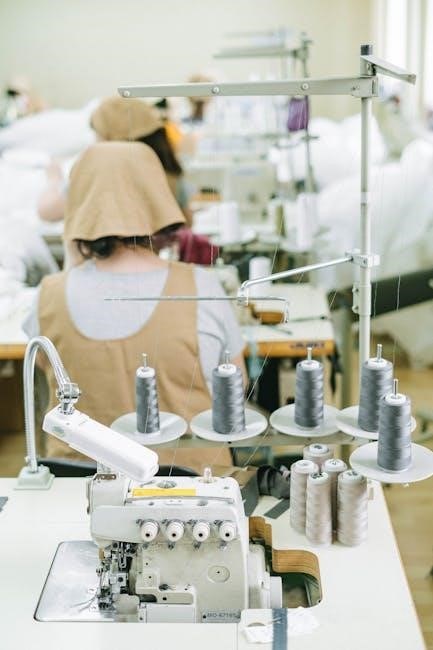
Advanced Features and Accessories
Advanced sewing machine laser guides offer customizable settings, compatible accessories, and smart device integration, enhancing precision and versatility for complex sewing projects and modern workflows.
8.1 Customizable Laser Settings
Modern sewing machines with laser guides often feature customizable settings, allowing users to adjust the laser’s intensity, alignment, and even color to suit their sewing needs. These adjustments ensure optimal visibility on various fabrics, from lightweight materials to dense textiles. Customizable settings also enable precise alignment for intricate patterns and embroidery, making it easier to achieve professional-level results. Additionally, some machines allow users to save preferred laser configurations, streamlining workflows for frequent projects. This adaptability enhances the overall sewing experience, catering to both beginner and advanced sewists, and ensures consistent accuracy across diverse sewing tasks and materials.
8.2 Compatible Accessories
Many sewing machines with laser guides offer compatible accessories to enhance functionality. Attachable laser units, embroidery frames, and extended alignment tools are popular options. These accessories allow users to expand the capabilities of their machine, catering to specific sewing tasks like quilting or intricate embroidery. Compatibility ensures seamless integration, maintaining the machine’s performance and precision. Additional accessories, such as adjustable laser mounts or fabric grips, further improve accuracy and ease of use. By incorporating these extras, sewists can tailor their setup to meet the demands of various projects, ensuring optimal results and versatility in their work.
8.3 Upgrading Your Current Machine
Upgrading your sewing machine with a laser guide can breathe new life into older models. Many modern laser systems are designed to be compatible with existing machines, allowing users to enhance precision without purchasing a new device. Attachable laser units or retrofit kits are popular options, offering improved accuracy and alignment. Before upgrading, ensure the accessory is compatible with your machine’s make and model. Researching reviews or manufacturer specifications can help you choose the right upgrade. This cost-effective approach lets you enjoy advanced features like customizable laser settings and improved stitch guidance, keeping your machine relevant for years to come.

Future Trends in Sewing Technology
The future of sewing technology promises smart device integration, enhanced laser precision, and eco-friendly innovations, revolutionizing how sewists create with efficiency and sustainability.
9.1 Integration with Smart Devices
Future sewing machines may integrate with smart devices, enabling wireless control via apps. This connectivity allows users to upload patterns, adjust settings, and receive real-time feedback. Voice commands and app-guided tutorials could enhance creativity. Smart devices could also enable remote troubleshooting, reducing downtime. This seamless integration aligns with the trend of smart home technology, making sewing more accessible and efficient. The ability to sync designs and settings across devices fosters a modern, connected sewing experience, appealing to tech-savvy crafters and professionals alike. This innovation promises to bridge traditional sewing with cutting-edge technology, offering unparalleled convenience and precision.
9.2 Enhanced Laser Precision
Future advancements in laser guide technology promise even greater precision, with improved optics and AI-driven adjustments. These enhancements will minimize deviations, ensuring flawless alignment and consistent stitching. The laser’s ability to adapt to fabric thickness and texture will become more refined, reducing errors in intricate patterns. This level of accuracy will be particularly beneficial for delicate fabrics and complex designs. Enhanced precision also means faster setup times and fewer corrections, boosting overall sewing efficiency. As technology evolves, laser guides will become indispensable tools for achieving professional-grade results, catering to both amateur crafters and seasoned professionals. This refinement will redefine sewing accuracy standards.
9.3 Eco-Friendly Innovations
Future sewing machine laser guides may incorporate eco-friendly innovations, such as energy-efficient technologies and recyclable materials. Manufacturers are exploring sustainable designs to reduce environmental impact, aligning with global efforts to promote eco-conscious products. These innovations could include biodegradable components, reduced power consumption, and minimal packaging. Additionally, laser guides might feature automatic shut-off to conserve energy when not in use. Such eco-friendly advancements not only enhance functionality but also appeal to environmentally aware consumers. By integrating green technology, sewing machines with laser guides can support sustainable practices while maintaining high performance and precision.
The sewing machine laser guide revolutionizes sewing by enhancing accuracy and efficiency, making it an indispensable tool for both professionals and hobbyists, ensuring precise and professional results.
10.1 Summary of Benefits
The sewing machine laser guide offers numerous advantages, including enhanced stitching precision, time-saving through guided alignment, and improved fabric management. It simplifies quilting, embroidery, and straight stitching, reducing errors and boosting creativity. This tool is versatile, accommodating various project sizes and fabric types. By ensuring consistent results, it elevates both amateur and professional work, making it an essential upgrade for modern sewing machines. Its benefits extend to efficiency and quality, proving to be a worthwhile investment for sewists seeking accuracy and reliability.
10.2 Final Thoughts on Laser Guides
The sewing machine laser guide is a valuable addition for sewists, offering unparalleled precision and efficiency. While some debate its necessity, many find it indispensable for achieving professional-level results. Its ability to streamline tasks like quilting and straight stitching makes it a game-changer for both beginners and experienced sewists. By reducing errors and saving time, the laser guide enhances creativity and productivity. Ultimately, it’s a worthwhile investment for anyone seeking to elevate their sewing projects with consistency and accuracy.
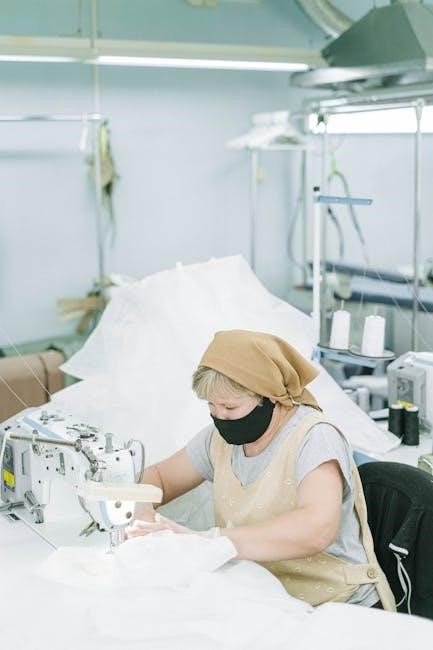



Leave a Reply
You must be logged in to post a comment.